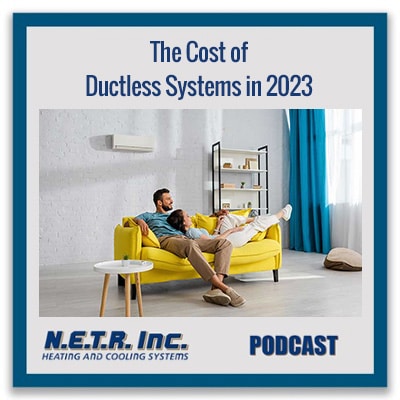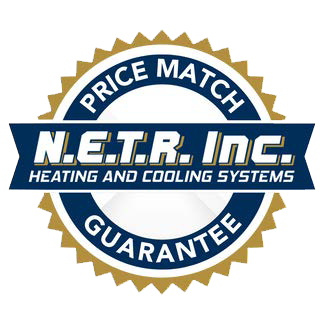
In this podcast, the General Manager of NETR, Inc, talks about the cost of ductless systems in 2023. He explains how costs have shifted over the years, and then, he outlines the factors that affect the cost of ductless heating and cooling.
John Maher: Hi, I am John Maher. I’m here today with Brett, General Manager of N.E.T.R., Inc., a heating and cooling company in Massachusetts with a focus on Mitsubishi ductless heating and cooling products. Today we’re talking about the cost of ductless systems in 2023. Welcome, Brett.
Brett Rogenski: Thank you for having me, John.
Cost of Ductless Vs. Traditional Heating and Cooling
John: Sure. So Brett, how do ductless heating and cooling systems differ from traditional HVAC systems in terms of cost?
Brett: Sure. It’s a little bit situational. A lot of times where we’re using ductless systems is when people don’t have existing ductwork. Perhaps, maybe someone has an older home or a home that was built with baseboard hot water heat and they don’t have duct work in their home. Traditional systems have an outdoor condenser and the cooling is distributed through the ductwork in the home. Folks that have boilers, folks that use hydronic heat don’t have that option.
For them, putting in a central air system would be prohibitively expensive. They’d have to run duct work throughout their whole house, cut in registers, box it in. With ductless, we can actually do all of that stuff on the outside of the house and simply make penetrations into the home and put wall heads on or floor heads or many other designs to serve that. It’s typically far more cost effective for most folks than actually going and doing what would be necessary to put in a central air conditioning system.
What Affects the Cost of Ductless?
John: Okay. Can you break down the different components of the cost of a ductless system, including the installation, the equipment, and maybe ongoing maintenance?
Brett: Sure. The components that really go into a ductless system are the outdoor condenser first, which is kind of the heart of the system. That’s the piece that does all the heating and it does all the cooling. There are different types of models depending on the need and size of the home. We have to get a BTU rating on how many BTUs of heating and cooling you’re going to need in that home, and also are you looking to heat and cool year round or are you simply looking to cool in the summer?
The outdoor component condenser would either be a standard heating and cooling or a cold climate heat pump and cold climate heat pumps are a bit more expensive than standard ones because they have to be able to operate and produce heat down to -13 Fahrenheit.
The next part is choosing the appropriate sized indoor heads. Those are the things, so again, they all have a BTU rating when we do our heat load calculation to make sure that each room in your home receives enough heat or cooling BTUs for proper comfort. Then the last part of that that’s really there is connecting those two things together, which is something called line set. That’s the copper tubing, insulated copper tubing, that then brings refrigerant to and from the condenser and the indoor heads as well as there’s some electrical wiring which is served in there as well. Those are really the big components.
What drives the cost? Well, do you need a cold climate heat pump or are you going to go with a standard one? The second part of that is how many feet of the line hide do you need on the outside? Then the third part of that is how big a unit do you need on the inside for each of those rooms? How many BTUs do you need in each of those heads? Those are really the driving components. I guess the last piece I would say is there is an electrical component because all of this has to be powered, so is it a simple disconnect or do you need any upgrades to your electrical in your home?
Financing Options for Ductless Heating and Cooling
John: Okay. Can you talk a little bit about the financing options that any N.E.T.R. offers for ductless systems and how homeowners can make this investment more affordable over time?
Brett: Sure, absolutely. The great news is there are a ton of financing options for homeowners. If they choose to purchase a system that qualifies for MassSave, first of all, they can gain rebates through MassSave, but they often as well can qualify for what’s called a heat loan. A heat loan is an 84 month interest free loan of up to $50,000 to finance this.
Option one would be a heat loan. Other options are Mitsubishi, who’s one of our primary vendors, they offer 24 month 0% financing for anyone purchasing Mitsubishi products. That’s a great option as well. Then we have several other finance options as well ranging from 12 month, zero interest, 18 month zero interest, onto as long as 180 months. There’s a lot of great options there. Again, the Mass Save piece is very popular for folks who qualify, but even folks who don’t qualify for that, there’s a lot of super options at zero or very low interest rates.
Maintenance and Operational Costs of Ductless
John: How does the cost of a ductless system compare to other types of heating and cooling systems when looking at energy efficiency and maintenance costs?
Brett: Well, that’s really where ductless separates itself, the efficiency rating. Ductless systems, depending on the size of them and your current situation, they often have a full return on investment through energy efficiency savings, little as two years to as long as maybe five or six years, but if you were to look at that compared to other options, it’s really a great option in how much you save in efficiency.
Your investment is very similar to fossil fuel options or other more conventional options, but your ROI is super strong because they’re so highly efficient. The other thing is they’re green energy. You’re not producing carbon, you’re not doing anything like that. They’re driven entirely through electricity, and that’s very important to many people. It’s also being legislated in many spaces now.
Innovative Technologies
John: Can you talk a little bit more about the innovative technologies or features that are available with ductless systems and how that impacts the overall cost effectiveness of the system?
Brett: Sure. Well, some things, there’s a lot of maybe old thinking about ductless systems, about heat pumps, mini-splits. First one is that they don’t work as a heating source in our climate, which is not true. Many years ago that was true. Ductless mini-splits using a cold climate heat pump now, you can comfortably heat your home easily down to -13. That’s the certification with the Mitsubishi Hyper Heat Systems, for instance. -13 ambient air temperature, you’re still able to fully heat your home.
That’s something that is a misconception out there and a great technology. The other part of that is there’s a lot more options on the inside of the home than most people think of. There’s certainly the wall mounted options, which many of us have seen, and they have a lot of smart technology in there to essentially sense occupancy and direct heating and cooling where it’s needed in the room.
The other thing is that there’s also other form factors that most people don’t know. There’s what are called wall floor mounts, which essentially look like a small floor register. It’s not up on your wall, it’s down low. That’s very popular folks who have Capes that maybe have a short knee wall on them and they can go in there. The other thing that we have is we also have air handlers, so people who have duct work in their home already can simply replace that heating and cooling air handler that they have that’s conventional with an air handler tied to a ductless mini-split, and it just disappears away into the duct work that’s existing.
I guess the last thing that many people don’t know is there’s a product called ceiling cassettes, which they recess into the ceiling. We have to make sure, obviously due to construction, that they’ll work for a given situation, but more often than not they do, and it gives a nice clean look. They just blend away into the ceiling and they still provide that full heating and cooling. Lots of great stuff, lots of great technology there.
Contact NETR to Get a Quote on a Ductless Mini Split
John: All right. Well that’s really great information, Brett. Thanks again for speaking with me today.
Brett: Thank you very much.
John: For more information, you can visit the N.E.T.R. website at netrinc.com or call 781-933-N.E.T.R. That’s 781-933-6387.
